Never deprive yourself of the pleasure of eating: this is probably the principle from which the idea of street food originates.
In a country like Italy, rich in ancient culinary traditions and extraordinary products, we can taste unique recipes even while walking immersed in the attractions of an art city or in the idyllic scenarios of nature.
Let's embark on the discovery of the 20 most beloved street foods by Italians (and not only!), traveling through the streets of the Bel Paese in a gastronomic itinerary that will give us a true cultural experience among the most authentic flavors of Italy.

A journey from North to South to discover Italian street food

In the world of modern gastronomy, street food plays a crucial role. This particular type of cuisine, characterized by practical and often inexpensive dishes, offers a wide range of flavors and regional specialties, making it the most authentic culinary expression of a territory's culture.
It’s precisely this strong territorial connotation that makes Italy the ideal place to discover the products and recipes typical of street food.
That's why we embarked on an itinerary from North to South of the country (including the islands), which will introduce us to one street food from each region.
From Genoese Focaccia to Apulian Panzerotti, from Trentino-Alto Adige's Bretzel to Roman Supplì: every bite is a journey through history and traditions of a territory, an unforgettable experience that will reveal the secrets of Italian popular cuisine.
20. Bread and Fontina DOP: the atypical street food of Valle d’Aosta

The street food of Valle d'Aosta perfectly reflects the geographical conformation of the region. Generally, street food is a characteristic element of cities, where in bustling streets one looks for a quick and inexpensive meal.
In Valle d'Aosta, however, we could almost speak of "mountain food”, or "trail food”. In this context, street food is identified by very simple and typical local products, such as Bread and Fontina DOP.
Fontina, in particular, is a food that is part of the region's history and culture: produced since the 13th century in the high mountains, where native cows graze and feed on fragrant forage, it has a sweet and full taste, as well as a soft texture when melted.
This cheese indeed has the ability to melt evenly, becoming creamy and with a rich and delicate flavor that pairs perfectly with the neutral taste and crunchiness of bread, for an authentic and satisfying taste experience.
19. Belecauda, the Piedmontese Farinata
The Belecauda, or Bela Calda, is a tasty variation of the classic Farinata, a common street food found between Liguria and Tuscany, boasting a very ancient origin dating back to the Roman Empire era.
Subsequently, this recipe developed in the Basso Piemonte, particularly in the Monferrato area, due to trade along the Via del Sale, and today it’s a regular presence at traditional village festivals.
Belecauda is a classic example of street food due to its simplicity: crispy on the edges and soft in the center, flavorful and perfect as a street snack. The characteristic of the Piedmontese Farinata, as the name suggests, is that it’s served very hot (in this sense, it resembles another typical Piedmontese recipe, Bagna Cauda).
Join a street food tour in Turin18. Sciatt della Valtellina: traditional flavors amidst the Lombardy mountains
The Sciatt of Valtellina are small and tasty buckwheat fritters, with a characteristic round shape, filled with melted cheese and often accompanied by chicory.
They owe their name to the Valtellina dialect term "sciatt", which means "frog." It’s presumed that they acquired this denomination due to the shape they take on during frying, which indeed resembles a small frog.
Beyond etymology, Sciatt represent an important culinary expression of the territory, a street food that fits perfectly into the context of Valtellina, beautiful land nestled among the mountains in northern Lombardy.
The use of buckwheat, a typical cereal of the area, gives this product a unique and authentic taste that reflects the natural resources and gastronomic culture of the region.
Thus, Sciatt embody the essence of a culinary tradition that values local ingredients and preparation techniques. Additionally, the combination of melted cheese and chicory adds a unique flavor note, making them ideal to enjoy along the picturesque streets of Valtellina.
17. Brezel from Trentino: a blend of taste and tradition

Bretzel, typical of Central and Northern European countries, is a street food that is particularly widespread in Italy's Trentino-Alto Adige region, where it is known as "Brezel". It’s a kind of bread with a thin, braided shape, featuring a glossy amber-colored crust adorned with many grains of coarse salt.
Originating in the 7th century A.D. and found in the streets of Germany, Alsace and Tyrol, Bretzels were often offered as gifts to important people during celebrations and weddings. Today, they have become an icon of not only German but also Trentino cuisine.
From a taste perspective, Trentino-Alto Adige's Brezels offer a unique blend of flavors. The crispy outer crust perfectly complements the soft, slightly sweet interior, creating a pleasant contrast that makes them irresistible, thanks also to the touch of coarse salt on the surface, which adds further flavor.
They represent a perfect savory option to enjoy during a quick break, perhaps paired with a mug of beer, or while exploring the most scenic places in the region, or even strolling through the typical Christmas markets of Trentino.
16. Frico, discovering Friuli's street food
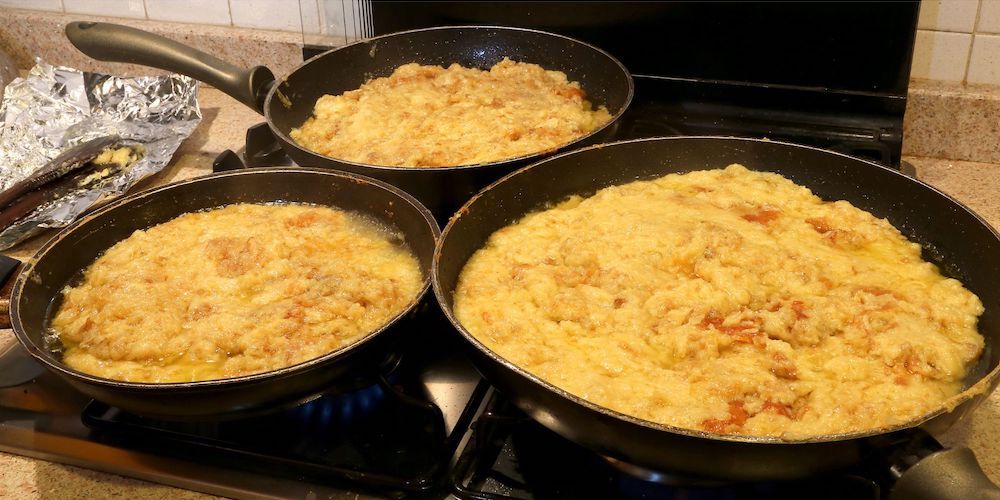
A true icon of Friulian street food, Frico is a gastronomic delicacy that embodies the history and culinary traditions of the region.
Its origins date back centuries and trace back to the mountain communities of Friuli, where it was prepared as a genuine and hearty dish to fuel long days of work in the fields, without wasting any cheese-making scraps.
Frico is a kind of cheese and potato omelette, often enriched with the addition of onions or other vegetables. The combination of melted cheese and potatoes offers an intense and enveloping flavor, for a recipe that is simple but requires skill in cooking to achieve the right external crispiness while keeping soft the inside.
There’s a deep connection between Frico and the Friulian territory, as the main ingredients (local cheeses and potatoes) are typical products of the region. Moreover, Frico is often associated with events and traditional festivals, where it is prepared and enjoyed by both tourists and residents.
15. Venetian Cicchetti: Sarde in Saor and Crostini with Baccalà Mantecato
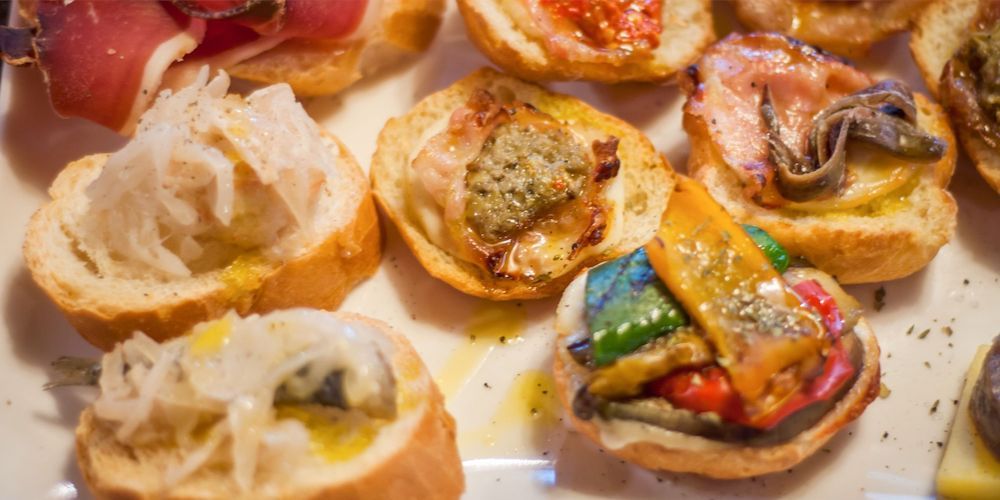
In Veneto, and particularly in the marvelous city of Venice, street food rhymes with Cicchetti. Cicchetti are nothing but small appetizers, or tapas, served in bacari, the typical Venetian bars.
They are usually accompanied by a glass of local wine, creating an authentic and convivial wine and food experience.
Among the most common Cicchetti are Sarde in Saor and Crostini with Baccalà Mantecato: the former are sardines marinated in a sweet and sour sauce made of onions, vinegar, raisins and pine nuts, reflecting perfectly the historical influence of maritime and oriental cultures on Venetian cuisine.
The Crostini with Baccalà Mantecato, instead, are slices of crispy bread spread with a cream made from dried cod, milk, olive oil, and garlic: a simple and tasty product, ideal street food to be enjoyed while walking through the most iconic places of such a unique and inimitable city as Venice.
Buy the Venice Pass, visit the most beautiful places in Venice14. Focaccia Genovese: the flavors of Liguria

Typical of Liguria, Focaccia Genovese represents a symbol of conviviality and Italian tradition to be enjoyed at any time of the day, either on its own or accompanied by ingredients such as cheese, cold cuts, or vegetables.
One of its most distinctive features is its soft consistency, enriched with numerous air pockets on the surface, also known as "buchi" (holes). This porous structure is the result of a slow and accurate leavening of the dough, giving the focaccia an unparalleled lightness.
The basic ingredients are incredibly simple (water, salt, and olive oil), and it is precisely this simplicity that makes this street food so special, able to win over palates with its authentic and genuine flavor.
The mild climate of Liguria and the abundance of local ingredients, such as olive oil and sea salt, have contributed to the spread and popularity of Focaccia Genovese, which over time has become one of Italy's culinary symbols and one of the most appreciated baked products throughout the country.
13. Piadina alla Romagnola, street food symbol of Emilia-Romagna
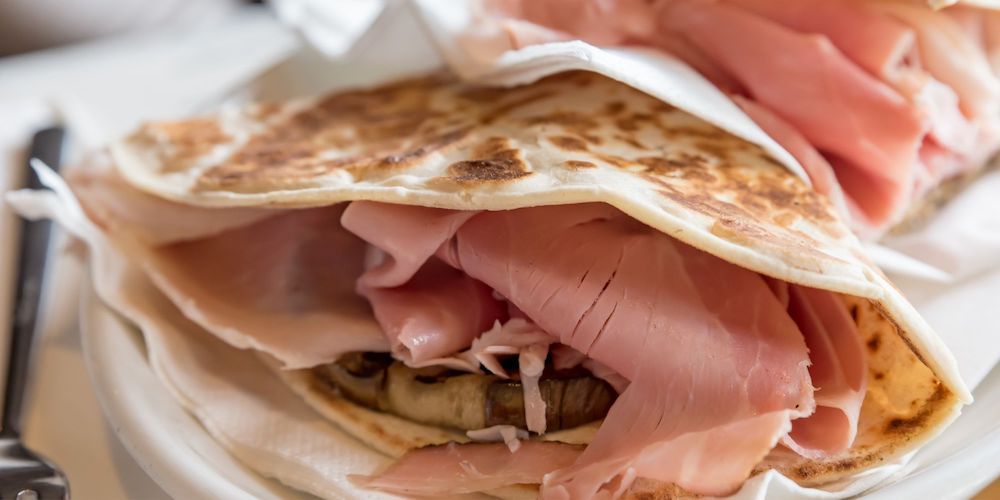
The Piadina alla Romagnola, an icon of Emilia-Romagna's street food, was originally considered a humble food, mainly consumed by farmers. Over the centuries, its fame has grown to the point where it has become an indispensable culinary symbol of the Riviera Romagnola and the entire region.
Crafted by hand, the Piadina, also simply called Piada, is a thin unleavened bread disk cooked on a special griddle called "testo", usually made of terracotta or metal.
In this way, it obtains a unique consistency and is ready to be filled with a limitless variety of ingredients, from classic fillings of cold cuts and cheeses to grilled vegetables or tasteful sauces. Not to forget the sweet variations with chocolate or jam!
The Piadina alla Romagnola is not only appreciated as a delicious street food but also for its cultural and social significance. It's often consumed at local festivals, where it represents an important moment of conviviality and sharing among people.
12. Panino with Lampredotto, a Florentine Tradition
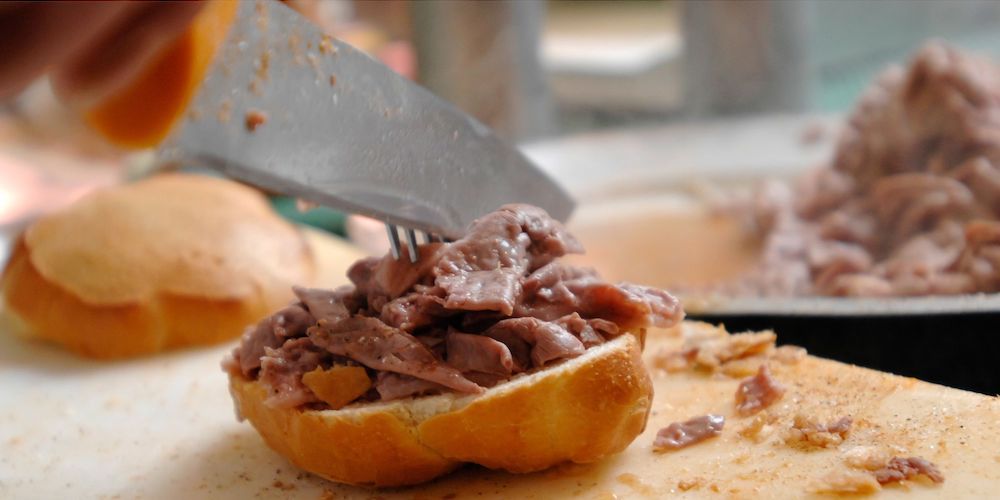
The Panino with Lampredotto is a must in Tuscan cuisine and Italian street food. It's a recipe that takes center stage in the streets of Florence, telling a story rich in tradition and authenticity.
Lampredotto is the bovine stomach, a less prized cut but full of flavor. In reality, the Lampreda is a freshwater fish similar to an eel, a particularly prized product that during the Renaissance period was enjoyed mainly by nobles and the wealthy.
The mouth of the Lampreda fish closely resembles the particular shape of the abomasum (which is indeed a specific part of the bovine stomach); that's why the citizens of Florence, who couldn't afford the luxury of enjoying the fish, decided with their classic irony to call the offal “Lampredotto".
As for the preparation, it’s first boiled in broth to make it soft and succulent, and then seasoned with simple ingredients such as salt and pepper, or enriched with a sauce made from eggs, capers and anchovies.
When ready, the Lampredotto is inserted into a round bun, ready to be enjoyed on the streets amidst the hustle and bustle of the markets and the enticing aroma of the stalls.
Join a gastronomic tour through the flavors of Florence11. Olive Ascolane: a journey through the Marche
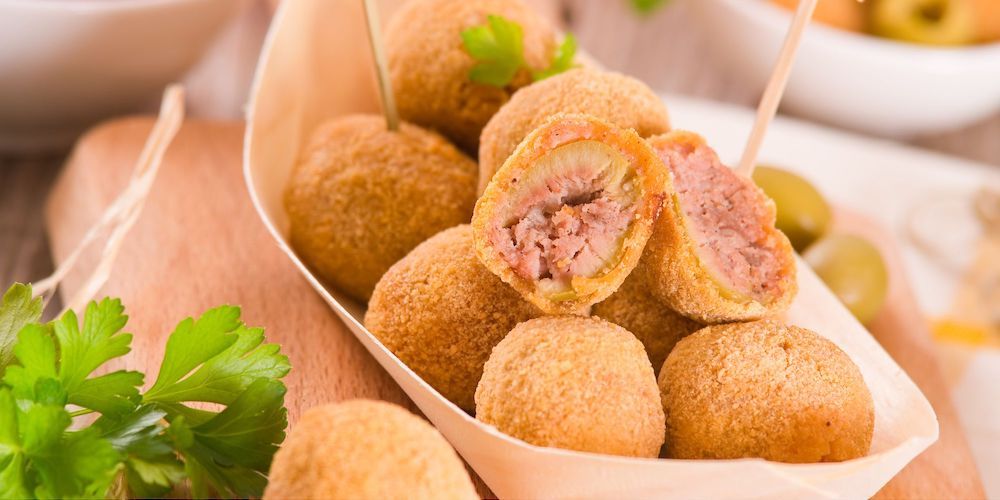
In the splendid and varied landscapes of the Marche, a region located in central Italy, amidst the rolling hills of the hinterland, the rugged coastlines overlooking the Adriatic Sea and the well-preserved medieval villages, the culinary tradition plays an extraordinarily important role.
In particular, when it comes to street food, one cannot overlook the tasting of a product that represents a true symbol of the region: the Olive Ascolane.
These are a type of olive native to the Marche, known for their unique green, soft, and crunchy flesh. They are harvested in September, then undergo a processing method to remove their natural bitterness, and are subsequently preserved in brine.
Their history dates back to ancient Roman times, but the recipe for Stuffed Olive Ascolane as we know it today dates back to the 19th century when a cook from an aristocratic family in Ascoli Piceno came up with the idea of stuffing them with leftover meat from a banquet.
Since then, they have become a beloved culinary icon, spreading from the nobility to popular tables and becoming an ideal gourmet street food to enjoy while strolling through the picturesque villages of the Marche and in the cities throughout Italy.
10. Torta al Testo: Umbrian Delight
Torta al Testo, commonly known also as "ciaccia" or “crescia", is a type of round, flat bread cooked on a "testo" (a kind of griddle) that can be filled with various ingredients such as sausages, cheeses and vegetables.
It's a very tasty street food with ancient origins, possibly dating back to the Etruscan civilization that inhabited the region before the Romans. In any case, this product was traditionally prepared by farmers and shepherds who brought the “testo” with them while working in the fields and cooked the bread over an open fire.
Today, we can enjoy Torta al Testo during festivals and celebrations, or simply while exploring the beautiful cities of Umbria, where exclusive events are held annually dedicated to this simple and delicious street food, reflecting perfectly the rich culinary traditions of the region.
9. Supplì alla Romana: the Origins of Rome's Stringy Heart

A ball of rice seasoned with meat ragù, mozzarella and other ingredients, then breaded and fried. Supplì alla Romana is a typical street food of Roman cuisine, also known as "Supplì al Telefono" for the stringy mozzarella that forms when it's split in half.
It seems that the name "Supplì" derives from the French term “surprise”, which precisely indicates the surprise felt in discovering and savoring the delicious mozzarella core. This aligns with the most probable hypotheses about the origin of this tasty product, which appear to date back to the arrival of the French troops in Rome in the early 19th century.
The French army had already occupied the Kingdom of Naples a few years earlier, which was previously under Bourbon influence, leading to a close connection between Neapolitan and Sicilian gastronomic culture.
Rice, brought to Sicily by the Arabs, became the protagonist of the Neapolitan "pall 'e ris”. This product, once arrived in Rome, took on a new identity, transforming into the famous Supplì.
Today, in addition to the classic version, there are variations with the addition of various ingredients, and the Supplì alla Romana has become a culinary symbol of the city and the entire Lazio region, a simple and perfect street food to enjoy while walking surrounded by the wonderful attractions of the Eternal City.
Learn to cook typical dishes of Roman cuisine8. Arrosticini, excellence of Abruzzo

One of the most famous, tasty (you can't stop at one!) and appreciated street foods in all of Italy: the Abruzzese Arrosticini are succulent skewers of sheep meat cooked over a grill or griddle. A gem of Abruzzo's culinary tradition, Arrosticini were born in the early 1900s, originally prepared using the less prized parts of sheep.
Indeed, the shepherds living in this area needed to minimize waste; to achieve this goal, they would cut pieces of old sheep meat and skewer them onto wooden sticks before cooking them over a blazing fire. In this way, they made even the less noble cuts edible.
Despite their humble origins, or perhaps because of them, Abruzzese Arrosticini have become a delicacy, a product that started in the splendid setting of the valleys of the Gran Sasso mountains to become an integral part of Abruzzo's culture and a gastronomic symbol of the entire country.
7. Pampanella, the meat skewers of Molise
From Abruzzo, we head south towards the small yet charming region of Molise. Here, we can enjoy a traditional street food not too different from Arrosticini: Pampanella.
It consists of pork meat, usually bacon or cheek, marinated with spices and herbs and then smoked. Subsequently, it’s skewered and slowly cooked over charcoal until it reaches a crispy texture.
The name "Pampanella" could derive from the term "pàmpino", which refers to vine leaves that were once used to cover the meat during cooking. Initially, this recipe was conceived as homemade, but over time it gained popularity through traditional festivals in local villages.
Thanks to its rich flavor and simplicity, Pampanella has become an icon of Molise's street food, rightfully joining the region's culinary tradition.
6. Pizza a Portafoglio: the secrets of Naples street food
The Pizza a Portafoglio (which means “Wallet Pizza”), undisputed protagonist of Neapolitan street food culture and also known as Pizza a Libretto, is a variation of the famous Neapolitan pizza.
Its size is slightly smaller than that of traditional pizza, and its distinctive feature is the way it is consumed: it’s folded twice upon itself, much like when closing a wallet. This allows us to both eat the pizza more easily while on the move and create space to add additional ingredients or toppings.
The origin of Pizza a Portafoglio is uncertain. It could indeed date back to 18th century Naples, although its success and spread occurred in the early 20th century. At that time, Pizza a Portafoglio represented the perfect quick meal for workers and travelers passing through, as it could be eaten on the street without the need for plates or utensils.
Its popularity has grown over time, transforming it from a simple street snack into a culinary icon of Naples and Campania.
Today, savoring a Pizza a Portafoglio while strolling through the picturesque streets of Naples’ historic center or along the stunning Lungomare represents an unmissable experience, an ideal opportunity to discover the extraordinary and authentic flavors of the city and the region.
Explore Naples and savor the authentic Pizza a Portafoglio5. Panzerotto Pugliese: the authentic taste of Salento

Originating from the Salento peninsula, but widespread throughout the region and especially in the capital city of Bari, Panzerotto Pugliese is a famous street food known for its crescent shape and delicious filling, appreciated by both locals and tourists lucky enough to taste it during a trip to beautiful Apulia.
The preparation of Panzerotto begins with a dough made of flour, water, salt and yeast, which is rolled out into thin sheets and then filled with a variety of ingredients. The classic filling includes tomato sauce and stringy mozzarella, but there are many regional variations that add ingredients such as ham, olives, or mushrooms, creating an endless array of flavors.
A distinctive feature of the Panzerotto is its cooking method, traditionally deep-fried in hot oil until it achieves a golden, crispy crust. This gives the Panzerotto an irresistibly crunchy exterior and a soft interior, with the melted cheese delicately melting in the mouth.
In addition to being so delicious, Panzerotti Pugliesi are also very convenient to enjoy on the go, making them an ideal snack to savor while exploring the region's streets, bathed in sun and surrounded by nature, art cities and wonderful villages.
4. Strazzata, a robust and flavorful street food from Lucanian cuisine
Strazzata is a traditional food of Lucanian cuisine, a rustic focaccia enriched with whole peppercorns. It's a perfect example of street food particularly popular during village festivals and Lucanian outings.
Preparing the Strazzata is quite simple: it involves a leavened dough, flattened and then punctured in the center. Subsequently, it's seasoned with extra virgin olive oil, salt and plenty of whole black pepper, to give the focaccia an even more intense and bold flavor. Once seasoned, Strazzata is baked in the oven until it achieves a golden and crispy crust.
This product represents a symbol of the local gastronomic culture, greatly appreciated for its rustic and genuine taste, as well as its history linked to peasant life and the ancient traditions of the region. These characteristics have made it a beloved street food for generations of Lucanians.
3. Pitta: a taste of Calabrian excellence
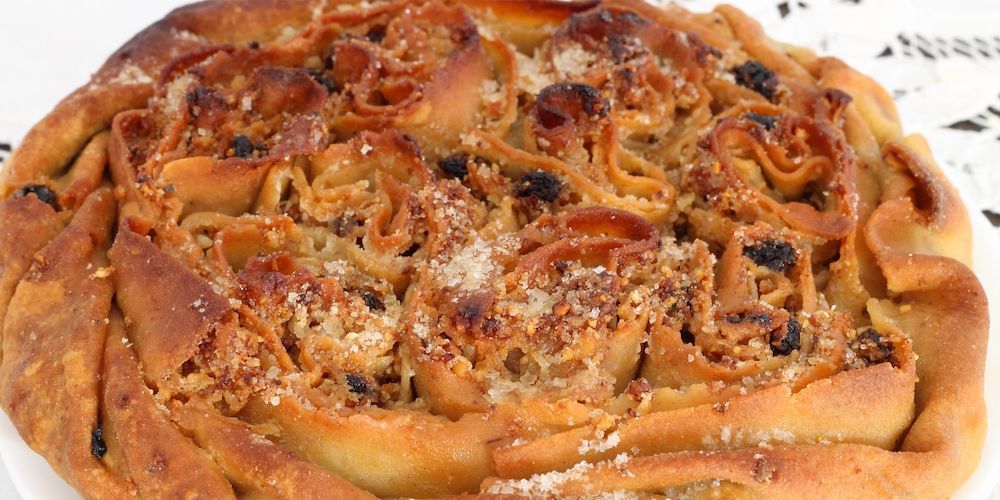
Pitta is a culinary delight that pairs perfectly with social gatherings, walks or simple snacks. Its preparation is relatively simple and requires few ingredients, but the result is a product with an excellent taste that represents the rich gastronomic tradition of Calabria.
Essentially, it’s a kind of stuffed sandwich, made with a dough of flour, water, salt and yeast, similar to that used for pizza, but with a firmer and more compact consistency.
The filling of the Calabrian Pitta varies according to tastes and local traditions, but usually includes ingredients with a strong flavor, such as extraordinary local cured meats and cheeses, anchovies, peppers, or the Tropea onions.
In the past, Pitta was a byproduct because it was only used to test the temperature of the wood-fired oven before baking the bread optimally.
Today, however, this street food is particularly widespread during festivals and village fairs, where it’s prepared and consumed in large quantities. It’s a versatile and appreciated food for its goodness and practicality, ideal to enjoy anywhere and at any time of the day.
2. Arancini or Arancine? A gastronomic journey through beautiful Sicily
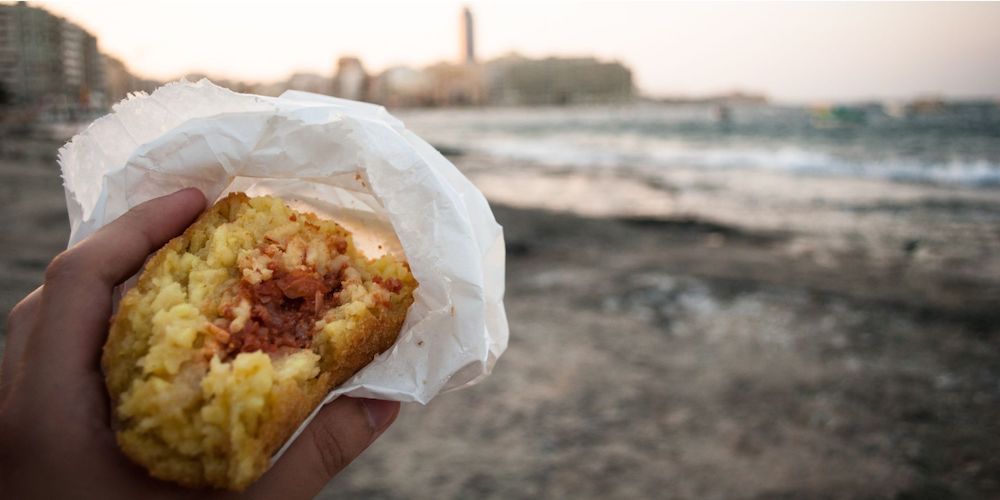
The debate over the name is still ongoing: "Arancini" for the people of Catania, "Arancine" for those from Palermo. What is certain is that, regardless of the name and shape, it's hard to resist the goodness of these saffron-infused rice balls, typically filled with ragù and peas, or ham and béchamel, and coated in a crispy breadcrumb crust!
The presence of saffron and meat reflects the culinary heritage of Arab culture, while the introduction of the breadcrumb coating seems to date back to Frederick II of Swabia: the monarch appreciated this recipe so much that he had it prepared for a complete meal during his hunting expeditions, with the golden crust making the food easy to transport.
Today, Arancini/e are a symbol of the region's culinary tradition, beloved by locals and tourists alike. In addition to the classic version, there are numerous regional variations offering a wide range of flavors and shapes. In Palermo, for example, Arancine are generally round; in Catania, on the other hand, Arancini are more often cone-shaped.
Beyond the differences, each bite of this extraordinary street food tells a tale of intense flavors and passion, making it a perfect symbol of Sicily's rich and diverse cuisine.
1. Seadas, the sweet street food of Sardinia

Let’s conclude our journey through the flavors of Italian street food in Sardinia with a delicious dessert of intense and refined taste: Seada.
Seadas are small sweet ravioli made of semolina pasta and cheese, externally seasoned with a generous layer of honey, which provides a satisfying sweetness and a delicate outer crispiness.
The presence of cheese, especially the typical Sardinian Pecorino (which has a more buttery taste compared to the Roman one), gives a taste in perfect balance between sweet and salty.
Some variations of Seadas also include the addition of grated lemon zest or a dusting of powdered sugar on the surface, further enhancing the flavors for this street food that is not just a pleasure for the palate but also represents an important regional culinary tradition, passed down from generation to generation.
About the author
Written on 17/04/2024



Alessia Cappa Colella
In the land of good food, even a walk becomes a great excuse for a delicious snack! Let's discover together the 20 most beloved street foods in Italy.